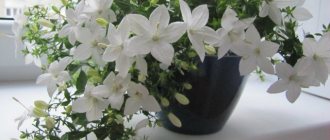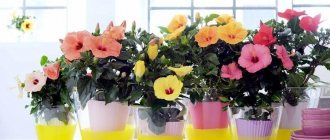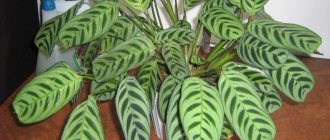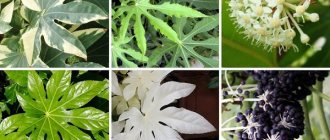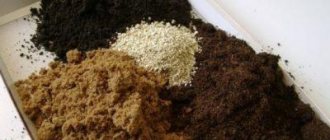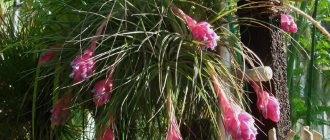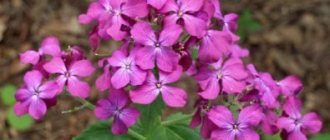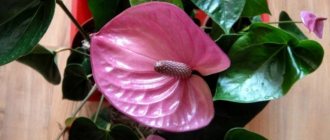Loading…
Loading…
Almost all exotic crops require special attention, but not bromeliads, whose home care consists of several simple procedures. Therefore, the plant is increasingly appearing on the windowsills of our compatriots. In addition, the flower won the hearts of flora fans with its unique decorative effect. What attracts bromeliads? What varieties are the most popular? How to grow and propagate a crop? What is the secret to successful home care? Let's find out what the experts say.
Description and photo
The bromeliad flower belongs to the large Bromeliad family, numbering 2,800 plant species. In its natural environment, the culture can be found in tropical and subtropical forests of Latin America, where it grows on the roots and trunks of large trees. But only ground-based varieties of bromeliads are suitable for home cultivation, such as:
- Guzmania.
- Ehmeya.
- Tillandsia.
- Freezea.
- A pineapple.
- Cryptanthus.
These varieties are endowed with common characteristics and similar conditions of detention. Therefore, in flower shops they are combined under the name “bromeliad mix”.
Exotic plants for the home are distinguished by dense, fleshy leaves with a glossy surface. They have a lancet shape and are collected in a dense rosette. Over time, a bromeliad flower grows from it. The buds of the culture are capitate, paniculate, spicate or racemose in shape. They are painted in bright, rich colors and are collected in simple or complex apical inflorescences.
This magnificence lasts for several months. But bromeliad blooms only once in its life, and after that the crop fades. But after the buds, children appear at the base of the plant, which are used to grow new bright specimens.
Types and varieties
Of the species of the genus Bromeliad, only the penguin bromeliad (Bromelia pinguin) , which is found naturally in Mexico, Ecuador, Venezuela and Costa Rica. This species, containing the biologically active enzyme penguinain, in nature produces large inflorescences of oblong fruits.
However, among flower lovers, it is customary to call bromeliads not only representatives of the genus of the same name, but also plants belonging to other genera of the Bromeliad family.
Guzmania, or Guzmania
This is a genus of epiphytic stemless plants native to Brazil, South Florida, the West Indies, Ecuador and Colombia and widely represented in indoor culture. The leathery, belt-shaped leaves of gusmania form a goblet-shaped rosette, in which morning dew or rainwater accumulates in nature, and the inflorescence located on the leafy arrow consists of inconspicuous flowers and bright bracts of yellow, orange, red and even purple. The following types and cultivars of guzmania are most often grown at home:
- Guzmania reed is a large plant with a dense rosette of bright green leaves reaching a length of 50 cm. On the back of the leaves there are brown stripes. On a short peduncle there is an inflorescence of small white flowers, which are almost invisible due to the orange or red apical leaves. Varieties: Minor, Tempo;
- Guzmania Nicaraguan is a medium-sized plant, ideal for growing indoors. It has an erect spike-shaped inflorescence with lemon-yellow flowers and scarlet bracts and a dense, compact rosette of 10-15 tongue-shaped light green smooth leaves up to 2.5 cm wide and up to 5 cm long, covered on the upper side with small scales, and colored on the lower side brown or purple.
In the photo: Guzmania
In addition to the described species, Guzmania mosaic, tricolor, blood red, Ostara, single-spike, Donnell-Smith and conifera are also grown at home.
Rules for caring for Guzmania at home
Vriesea
A genus of South American tropical plants with large, bright paniculate or spike-shaped inflorescences and decorative rosettes of juicy, dense, long leaves. Among them there are both epiphytes and terrestrial forms. The most famous species in indoor culture:
- Sanders's vriesea is a plant with a rosette up to 60 cm in diameter and up to 40 cm in height, made of smooth leathery leaves with a grey-green, often purple tint, more clearly visible on the underside of the leaf blade. A drooping or straight peduncle is crowned by an inflorescence of spike-shaped racemes, consisting of yellow flowers and stipules of the same shade;
- Vriesia beautiful, or brilliant, is an inhabitant of tropical rainforests with a rosette of broadly lanceolate, variegated leaves, as if covered with dark transverse strokes, up to 40 cm long. The color of the stripes can be either dark green or purple. On an erect peduncle, a wide lanceolate spike of yellow flowers and bright carmine-red bracts is formed.
In the photo: Vriesea
In addition to the described species, Vriesia keeled, royal, perforated, hieroglyphic and even giant are also grown at home.
Conditions for growing Vriesia in an apartment
Aechmea
This is a genus of epiphytic plants common in South and Central America with leaves serrated along the edges, forming funnel-shaped rosettes, and with bright inflorescences on a long, thick peduncle. The most popular types grown at home:
- Aechmea matte red is a plant with a dense funnel-shaped rosette of tongue-shaped leaves, light green on the upper side and lilac on the underside, up to 50 cm long with finely serrated edges and scales located along the leaf plate. The inflorescence consists of pale blue flowers and bright red bracts;
- Aechmea sparkling is a plant with a free rosette of pale green, belt-shaped leaves with a bluish bloom, up to 40 cm long and up to 6 cm wide, with a serrated edge and a rounded apex. An inflorescence of coral-red flowers with a blue tip and bright pink bracts is formed on the peduncle.
In the photo: Aechmea
In indoor culture you can also find Aechmea holostem, caudate (bearded), striped, shaggy, curved, two-row, Weilbach and others.
How not to ruin echmea on the windowsill
- Sprekelia
Tillandsia
This is a type of herbaceous plant, numbering about 500 species, growing in the nature of South and North America. Most of these plants are epiphytes, but the genus also includes lithophytes and terrestrial species growing on stones. Some types of tillandsia are popular indoor plants:
- Tillandsia “Jellyfish Head” is the most famous species of unusual shape, resembling a bulb with closed leaf bases that bend to the side only at the top. The rosette of leaves is usually inverted, the bright purple flowers reach a length of 32 mm, and the inflorescences are linear or finger-shaped;
- Tillandsia blue is a species with narrow curved leaves up to 30 cm long. The base of the leaf blade, covered with small scales, is reddish-brown. The plant blooms in a dense elliptical spike-shaped inflorescence of small blue or purple flowers and lilac or pink bracts.
In the photo: Tillandsia
Tillandsias of Duer, Linden, rush, silver, Gardner, violet and others are also popular.
Tips from a professional for growing Tillandsia
Neoregelia
It is a herbaceous perennial from Peru, Colombia, Brazil and Ecuador with smooth, glossy, belt-shaped, broadly linear leaves with spiny edges. In the center of the rosette, the leaves are often whitish or light purple, and during flowering they turn red at the ends or completely. The racemose inflorescence emerges from the center of the rosette. The most famous species of the genus:
- Carolina neoregelia is a plant with a wide-spreading funnel-shaped rosette up to 50 cm in diameter of bright green glossy tongue-shaped leaves with dense spines along the edge. At the beginning of flowering, the upper leaves of the rosette turn red. A simple capitate inflorescence is formed deep in the rosette and consists of pale lilac flowers up to 4 cm long and milky green bracts. The species has varieties with pink, green or white longitudinal stripes along the leaves;
- Neoregelia tiger is an epiphyte with a dense round rosette of tongue-shaped leaves with a pointed tip and brown spines along the edges. The leaf blade is decorated with irregular brown stripes, and at the base the leaf is covered with small scales. The inflorescence of this species is simple, multi-flowered, consisting of reddish apical, asymmetrical spatulate bracts and pale purple flowers.
In the photo: Neoregelia
Other types of neoregelia are also grown at home: blue, bubbly, offspring, few-flowered, beautiful (elegant), gloomy, marble and others.
Home care
Bromeliad is an unpretentious plant. But in order for it to please you longer with its flowering and decorative appearance, create comfortable conditions for the culture that are close to natural. The following agrotechnical measures will help with this:
- regular watering;
- periodic feeding;
- prevention of diseases and pests.
In addition, it is important to maintain optimal humidity, temperature and lighting near the crop. How to do this is described in detail in this article.
Where to place bromeliads in the house
The first thing to remember is that she needs a corner with the highest level of humidity. A successful combination is to have an aquarium next to it. Special air humidifiers are used for this purpose. Place containers of water next to the plant.
The second rule is protection from drafts and directed sunlight. It is not recommended to turn on air conditioners and fans near the flower. Although it is necessary to ventilate the room. Stagnant air is unfavorable for an exotic beauty. If there is no draft, then in the summer you can keep the window open.
She feels comfortable on eastern windows.
Bromeliad on the window
What to do after purchase
An attractive plant for the home, bromeliad is sold in flower shops in two forms:
- young crops that do not yet have buds;
- already blooming, luxurious specimens.
If you buy a bromeliad that has not yet blossomed, carefully inspect the plant. There should be no signs of mechanical damage or rot. Having purchased a healthy specimen, immediately transplant it into a new pot. This way the plant acclimatizes faster to your conditions.
It is not recommended to replant adult, already flowering bromeliads. They do not tolerate the event well and may die after the procedure. But before you add your new pet to other house plants, keep it in quarantine separately to make sure that the bromeliad is healthy and does not carry diseases.
How to choose a healthy plant in the store
It is not difficult to determine that the plant you are purchasing is healthy. Green fleshy leaves form a rosette. Some species have a pronounced marble pattern on the surface. Bromeliads do not have a trunk, the peduncle rises above the rest, and is always bright in color.
Based on ideas about the appearance of a healthy plant, it becomes clear: the presence of spots, plaque on the leaves, and their softening guarantee that the flower is sick.
Appearance of bromeliad
Soil and pot
Before transplanting a flower, prepare the soil for the crop. Bromeliad prefers well-drained, light and loose soil with a slightly acidic reaction. For planting the plant, soil intended for orchids is suitable. To create a substrate yourself, mix peat with sand in a ratio of 2 to 1. It is useful to add a little wood ash, sphagnum moss, perlite or coconut fiber to this mixture. This will improve the looseness of the substrate.
Pathogenic microbes and pests often live in the soil. To protect the plant, be sure to disinfect the substrate before planting. To do this, heat the soil in the oven or hold it over steam.
The roots of the plant are superficial. Therefore, the flower feels more comfortable in wide but shallow containers. But do not try to immediately plant the crop in a pot that is too large. Because of this, its decorativeness decreases. Ceramic is the most suitable material.
Transfer
Wear gloves when handling bromeliads. The plant is not poisonous, but most varieties of the flower have sharp thorns at the tips of the leaves, which are easy to injure. How to replant a flower:
- Place a layer of drainage consisting of broken bricks, expanded clay or pebbles at the bottom of the pot. Please note that these materials should occupy a third of the volume of the container.
- Carefully remove the flower along with the earthen lump from the old pot. To make this easier, moisten the soil 3-4 hours before the event.
- Place the bromeliad in a new pot without destroying the earthen ball.
- Fill the voids with prepared soil. Make sure that the root collar is level with the ground.
- Compact the soil and water it with warm, settled water.
After replanting, place the flower in a suitable place and provide proper care for the bromeliad at home.
Signs and superstitions associated with indoor flowers
Although there are few superstitions associated with bromeliads, they are all positive. It is believed that the flower has the ability to improve people's mood and bring peace to the home. When caring for a bromeliad, your daily routine becomes orderly and stable. The flower is useful to grow for people whose life and work are full of frequent experiences.
The flower has the ability to attract positive energy into the house and protect the aura of its owners from ill-wishers.
Bromeliad also helps overcome self-doubt and unleash creativity. Therefore, it will be useful to install a flower in a child’s room or in the office of a creative person. Caring for a flower helps you relieve stress, start thinking positively and seeing the positive sides in any situation.
Bromeliad can become a symbol of home and financial well-being. Since the plant needs painstaking care, it can teach owners to take a responsible approach to their work, perform tasks diligently and achieve their goals.
Content temperature
This tropical beauty easily tolerates temperature changes and can easily withstand heat of +38 °C in summer. In winter, a drop to +12 °C is permissible. But still, bromeliads will be more comfortable at any time of the year at +23…+25 °C. Although in winter it is still worth placing an exotic guest in a room with +18 °C.
In summer, do not be afraid to take bromeliads out onto the balcony and even into the garden. Then the plant will be saturated with fresh air, which will have a positive effect on its decorative effect. But choose areas for cultivation in partial shade, protected from wind and rain.
In winter, do not allow the plant to suffer from drafts. But ventilate the room regularly. After all, stagnation of air is detrimental to a flower.
Location
Bromeliads in apartment conditions are placed on eastern or western windowsills. The plant needs bright, but diffuse lighting; direct sunlight can leave burns on the leaves. On southern windows, the flower will have to be covered from the sun's rays with a translucent curtain.
In winter and early spring, flowering bromeliads need to be provided with additional lighting, extending daylight hours to 12 hours.
Important! The light from the lamps should not be directed directly at the flower. It is better if it is reflected from the ceiling or passes through a special scattering screen.
The tropical guest does not tolerate drafts. It is necessary to make sure that the plant is not exposed to air flow from the air conditioner and is not blowing from a window or vent. A comfortable temperature for the plant is about 25 degrees Celsius. When bromeliads enter a dormant state, the room temperature is reduced to +18 +20 degrees.
Guzmania
Watering
Bromeliad is a moisture-loving plant, and the tropical beauty needs regular watering. But you should not allow moisture to stagnate at the roots. Therefore, water the flower as soon as the top layer of soil dries two fingers deep. If you grow species that have a reservoir in the center of the outlet, then fill it with water. But keep in mind that such “watering” is suitable for plants grown in good lighting. In addition, the tank can be filled in the warm season.
To water bromeliads, use rain, melt or distilled water. If this is not possible, filter and leave for 2-3 days using regular tap water. Do not use metal containers to collect and store water. As a result, color development is noticeably inhibited.
Brief information about bromeliads
Bromeliads are related to pineapples as they belong to the same family, the bromeliads. It is named after the Swedish botany lover and physician Olaf Bromelius, who lived in 1639-1705.
The homeland of this exotic culture is Latin America and the West Indies. Therefore, it is desirable to create conditions similar to a tropical climate for it.
Local residents collect wild bromeliad fruits, eat them, and prepare soft drinks from them.
The process of the emergence of this beauty began a very long time ago - presumably more than 200 million years ago. In an effort to survive, escaping floods, she settled on rocks or trees.
Interesting Facts. Findings of fossilized remains of bromeliads in South America have suggested that they are more than 30 million years old.
When talking about bromeliads, Florida must be mentioned. It is home to 16 of its species. Moreover, 13 varieties are not found anywhere else in the world. Florida is famous for the presence of more than 13 bromeliad communities, as well as their commercial breeding.
Bromeliad appeared in botanical gardens and parks in North America thanks to Mulford Foster. He brought it back from his travels. His villa, Bromela, appeared near Orlando. Together with his wife, he was engaged in breeding new varieties. More than 100 hybrids were added to the 200 imported species.
There are both terrestrial varieties and those growing on trees. There are many types of it for breeding at home. This rich family is united under a common name – “bromeliad mix”.
Bromeliad in nature
Why does she attract our attention? Its decorative value is not only in flowers. Its lancet leaves remain green at any time of the year. They are collected in a neat rosette, dense and fleshy, growing up to 50 centimeters in length. Some species have spines on the sides.
Peduncles emerge from the rosette. The peculiarity and originality of these plants are brightly colored bracts (they are often mistaken for a flower), inflorescences in the form of a head, spike, brush or panicle of different colors. Breeders even managed to breed two-color bromeliads. Bromeliad fruits are berries.
Interesting to know. With the end of flowering, the main rosette dies off, but there are side shoots nearby. With their help, a new plant is grown. The dried rosette is carefully removed.
There are a number of folk signs about this exotic beauty, and they are all positive:
- being in the house promotes a good mood and peace, and relieves stress;
- it brings peace to the home;
- bromeliad promotes the development of creative abilities, helps get rid of self-doubt;
- it attracts positive energy into the home and protects it from ill-wishers.
Residents of various countries are showing interest in it. Connoisseurs and collectors of this family created the International Society of Bromeliad Lovers in 1950. Many of them come to South America to wander through its jungle thickets in search of a new variety.
Air humidity
In its natural environment, bromeliads bloom during the rainy season. And if you want to see the buds of your pet, then create similar conditions for it. To do this, install a special humidifier next to the pot. If this is not possible, then place the container with the flower on a tray with pebbles. Fill it three-quarters full with water, but make sure that the moisture does not touch the drainage hole, because the roots breathe through it.
In addition, do not forget to regularly spray the foliage of the exotic plant. Moreover, carry out such procedures 2-3 times a day. Use settled or rain water for spraying. Its temperature should be room temperature. Wipe the leaves with a damp sponge once a week. And every month, clean the leaf rosette from the dirt that inevitably accumulates in it.
Pests and diseases of bromeliads
Bromeliad diseases and their treatment
Very rarely, bromeliads are affected by fungal diseases such as rust and powdery mildew. In order to cure a diseased plant, it and the soil mixture in the pot are sprayed several times with a fungicide solution containing copper. Protect the flower from direct scorching rays of the sun, as they can cause burns that look like brown spots to form on the surface of the foliage; therefore, at midday it should be shaded; for this, the window can be covered with a light curtain.
If liquid constantly stagnates in the root system of the plant, then the foliage of the bromeliad loses turgor and begins to turn yellow, especially if the room is also cool. If watering is too sparse and the air humidity in the room is very low, then the tips of the leaf blades turn brown. From this it becomes clear that the bush becomes sick due to improper care or unsuitable growing conditions.
Bromeliad pests and their control
Also, due to non-compliance with the rules of care, various harmful insects can settle on a weakened bush. Most often, scale insects or mealybugs settle on it. Pests should be removed from the flower manually, after which the leaf blades on both sides are wiped with a cotton swab, which is pre-moistened in a soap solution. After some time, the bush must be washed with clean water, and the surface of the soil mixture in the container must be covered with film. If harmful insects still remain, the bush should be sprayed with a solution of an insecticidal preparation (Aktara, Fitoverm or Actellik). However, during processing, do not allow any chemical to enter the funnel. An excellent substitute for chemicals in pest control will be tobacco infusion.
Feeding
To make your bromeliad bloom longer, fertilize your exotic beauty regularly. But remember that overfeeding is more dangerous for the crop than “dieting”. Therefore, do not be overzealous with the formulations and do not exceed the dose. Moreover, it is advisable to dilute the drugs by half or three times what is indicated in the instructions.
There are two types of feeding bromeliads:
- Basal, in which fertilizers are applied directly to the soil.
- Foliar feeding is carried out using a sprayer, spraying nutritional compositions onto the leaves and into the rosette of the crop.
To fertilize bromeliads, use liquid mineral complexes intended for orchids. And a universal fertilizer for flowering crops is also suitable. In winter, apply medications 1-2 times a month. During the growing season and flowering, feed the flower every 15-20 days.
Names of Bromeliad species
The Bromeliad family includes about 3,000 species names, but epiphytes, shown in the photo, are popular in floriculture - plants whose root systems are mainly needed for attachment to tree trunks:
- ehmeya;
- Guzmania;
- cryptanthus.
You may be interested in:
Growing balsam from seeds at home Balsam is a beautiful and unpretentious flower that does not bloom for long, but is very beautiful. The buds are different…Read more…
Aechmea is a perennial known for its decorative leathery leaves and bright large inflorescence. Indoor specimens reach 30-90 cm in length, while in the natural environment Aechmea sometimes grows up to 2 m. The leaves of the flower are long - up to 50 cm, have a linear or belt-like shape, and a chaotic pattern. The edge of the leaf blade can be pointed or rounded. At their base, the leaves of echmea form a rosette with a funnel in the center.
During flowering, a large spike-shaped or capitate-shaped inflorescence with a dense peduncle appears on the plant. One inflorescence can contain many shades of pink, lilac and blue. Aechmea is a poisonous plant, its juice can irritate the skin, so you need to wear gloves when caring for an exotic plant.
Guzmania is a tropical plant characterized by oblong, glossy leaves arranged in a rosette from which emerges a spike-shaped inflorescence. The inflorescence is formed from bright leaves-bracts, between which there are white and yellow small flowers. Flowering lasts 4 months, after which the plant dries out.
Guzmania
There are several different types of guzmania, each with unique blooms:
- guzmania blood-red – corymbose inflorescence, consists of 7-12 flowers; when flowering, the leaves become deep red;
- guzmania mosaic - the rosette of the flower looks attractive even before flowering. The species is characterized by long leaves with green and red-brown stripes;
- guzmania reed - the inflorescence is formed by bracts of pink or bright red leaves.
Cryptanthus is an “earth star”, a perennial whose distinctive feature is the absence of stems. The flowers of the plant are located in deep, dense foliage, so it can be difficult to see them. Stripes of long leaves can have different shades: green, yellow, red, white.
Cryptanthus
The edges of the leaves are wavy, serrated, and compensate for the not very attractive white inflorescences. Cryptanthus is the smallest and most whimsical representative of the bromeliads.
Growing new flowers
After flowering, the plant gradually fades and fades. And if you want to get new specimens of a tropical crop, then start propagating bromeliads by children. To do this, do not wait until the bud withers, cut it off with a sharp, disinfected knife. Continue to water the crop, but less intensely. And then, after a while, babies will appear in the root part, which are also called kicks and puppies. They are used for reproduction.
Before planting the bromeliad babies, add soil to the pot with the mother plant. This is necessary so that the kicks can take root and grow more easily. Typically, this process takes 2-3 months. All this time, water future flowers in the same way as adult plants.
Transplant children from February to April. At this time, plants take root more easily. For new specimens, select suitable containers and prepare a substrate. Cut the babies from the mother plant with a sharp knife. Treat the cut areas with crushed activated charcoal or charcoal. Before planting, dry the kiki for 1-2 hours. Plant the babies in pots with moist soil and good drainage and place the plants in a warm, bright place.
At first, feed the seedlings once a week and water the soil as needed, preventing the soil from drying out. In the future, provide young bromeliads with regular care. When their roots become stronger, fill the pot and begin to protrude from the drainage hole, transplant the crops into larger pots.
Reproduction
The plant is propagated using shoots that appear on the bromeliad bush immediately after flowering. They are allowed to grow to a height of a third of the size of the mother bush (usually this takes 40 - 50 days), then the shoot is carefully cut off, along with the roots. The cut on an adult plant and cuttings must be sprinkled with crushed charcoal.
The bromeliad shoot is planted in a light substrate made from a mixture of peat, sand and soil for orchids. Fix it in the ground for stability with a wire pin and place it in a warm, bright place for rooting. Plants are watered regularly, preventing the substrate from becoming waterlogged. Within a month and a half, the bromeliad sprout will take root.
The young plant will be ready to flower 2 years after planting.
Photos of flowers
Speeding up flowering
If you transplanted the children according to the rules, but they do not produce buds, then you will have a question why the bromeliad does not bloom. The fact is that young seedlings are not capable of this. And crops that have reached two years of age bloom. But for this it is important to maintain comfortable conditions and not violate the rules of care.
A little trick will help speed up the flowering of bromeliads. Take a few rotted apples or bananas and put them in a bag along with the plant. But before that, remove water from the leaf sinuses and wipe the central reservoir dry. Then, under the influence of ethylene, the plant will produce buds faster.
Provide proper care for bromeliads at home, and the exotic plant will reward you with long-lasting flowering and an attractive appearance. To do this, follow the recommendations and create a comfortable environment for the culture.
Characteristics of indoor bromeliad flower
The most attractive external part of the plant is the bright flowers, they come in a wide variety of colors: from soft pink to purple. Thanks to the work of breeders, plants with white and scarlet flowers are also found in floriculture. Bromeliad leaves, which can reach up to 50 cm in length, are large and stiff, and some species may have small spines on their edges.
The leaves form a rosette to collect moisture in their natural habitat. The same outlet is intended for watering plants at home. The root system of bromeliads cannot be called well developed, and therefore the flower receives most of its moisture through the rosette.
Bromeliad flowers can be collected in both simple and complex inflorescences and have a double perianth. The bracts are brightly colored. Bromeliad fruits are found in a capsule or berry, which can grow together into fruit. As a rule, the mother rosette dies off immediately after flowering, but the side shoots remain - with their help the plant can be propagated.
With regular watering and feeding, bromeliads can bloom in 2-3 years of life. The plant blooms only once during its life cycle, after which it dies.

